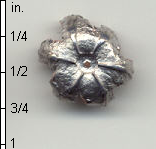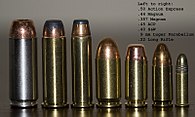9 × 19mm Parabellum
The 9 × 19 mm Parabellum (abbreviated as 9 mm, 9 × 19 mm or 9 × 19) is a cartridge for pistols, submachine guns and carbines designed by Georg Luger and introduced in 1902 for its Parabellum semi-automatic pistol. For this reason, it is designated as 9 mm Luger/9 mm Luger +P by SAAMI and as 9 mm Luger by the C.I.P. (differentiating it from the 9mm Makarov and 9mm Browning cartridges). NATO adopted it under the STANAG 4090 standard, as a standard cartridge for the armed forces. It was used by the German armed forces in World War I and World War II with the Luger P08, Walther P38 and Astra 600 pistols, as well as like the MP40 submachine gun. Since the conflict it has become one of the most used cartridges in the West. It receives its name from the famous Latin maxim Si vis pacem, para bellum ("If you want peace, prepare for war"). Add as historical data that " Parabellum" It was the telegraphic address of the DWM factory and possibly this cartridge received such a name for this reason.
Development
After World War I, several pistol models using the 9mm Parabellum caliber were adopted by various countries and after World War II the use of this caliber expanded more rapidly. To continue using lead in bullets during World War II, the lead core was replaced in Germany by an iron core jacketed with lead. This black bullet was brown and was designated "08mE". Another World War II version is the "08SE" dark gray jacket, created from iron compressed at high temperatures into a solid material called Sintereisen or sintered iron. A special version of the bullet called "X" or with 9.7g green sheath and FMJ with subsonic velocity was produced by the Germans for silenced pistols during World War II. Other countries also designed versions of heavy and subsonic bullets for silencers.
The 9mm Parabellum caliber has been manufactured by or for more than 70 countries, and is currently the standard caliber for pistols, especially for NATO and other armies around the world. After World War II, the common bullet weight is 8 g to increase the ammunition's accuracy. Cartridges with 9.5g bullets are still sold. It does not pierce body armor, unless it is special Russian armor-piercing ammunition, such as the 9N21 or 9N31.
Features and benefits

The 9mm Parabellum caliber combines a flat trajectory with moderate firing impulse and sufficient stopping power. The main advantages are its small size and less use of resources to manufacture it. The main disadvantages are the tendency of non-expanding bullets to overpenetrate, producing a small cavity wound.
It is a suitable caliber for the hunting pistol. Due to its low cost, easy manufacturing and effectiveness in many circumstances, it became the most used caliber in the world for pistols. In the United States it is a popular caliber among civilians for self-defense and target practice due to its low cost, moderate shot impulse, and the enormous variety of pistol models available for this caliber.
The police, with the exception of the Argentinians, use a version with overpressure (+P) and hollow point bullets (JHP) that increase stopping power. The 9mm Luger caliber was very popular for police use in the 1980s and 1990s, but has been replaced by the.40 S&W caliber due to its poor results in shootings. There is endless controversy in the United States and other countries over whether or not the 9mm Parabellum is appropriate for self-defense and Police.[citation needed]
Design

Based on the 7.65mm Parabellum pistol cartridge, Luger designed the 9mm Parabellum at the arms company Deutsche Waffen und Munitionsfabriken A.G. (DWM) and introduced a version of its Luger "Parabellum" to the British Small Arms Committee in 1902. The 9mm Parabellum cartridge was created by removing the bottleneck of the 7.65 Parabellum cartridge. Three prototypes of the 9mm Luger gun were presented to the US Army for testing at the Springfield Arsenal (Springfield Armory, then a state arsenal, not to be confused with the current private company of the same name) in 1903. The German army showed interest in a version of the pistol in 9 mm Parabellum in 1904. In the United States the cartridge became known for the Luger pistol, for that reason in that country and in others it is also known as "9mm Luger". The original design was a jacketed bullet (full metal jacket or FMJ), with a truncated conical shape of 8 grams. In Germany, the bullet was replaced by the same FMJ of the same weight and ogival design from 1915 to 1916, but truncated nose bullets continued to be used in the United States.
Sheath


- Brass: since 1902, it was the common material. For its appearance, durability or vain identification has been nickel or painted copper.
- Aluminium: Aluminium pods have been produced since 1941 in Switzerland.
- Steel: Several countries have experienced the use of steel in the pods since World War II. Their introduction was unsuccessful, but they continue to occur and are available in Russia.
- Other materials: In several countries, some polymers have been used to manufacture parabellum 9 mm pods.
SHIP ammunition
Hypervelocity cartridge for police use developed by Rudi Basch in Argentina. A 63-grain bullet at 1803/1810 fps with a 5-inch Browning HP35 barrel (standard pistol) Later models of 56-grain gold metal bullets recorded 2400 fps in the same 5" of Browning and Glock pistols. Pressure determined by the signs on the primers and cases, they do not show overpressure.

Contenido relacionado
Ammonium
Donald glaser
Endemism